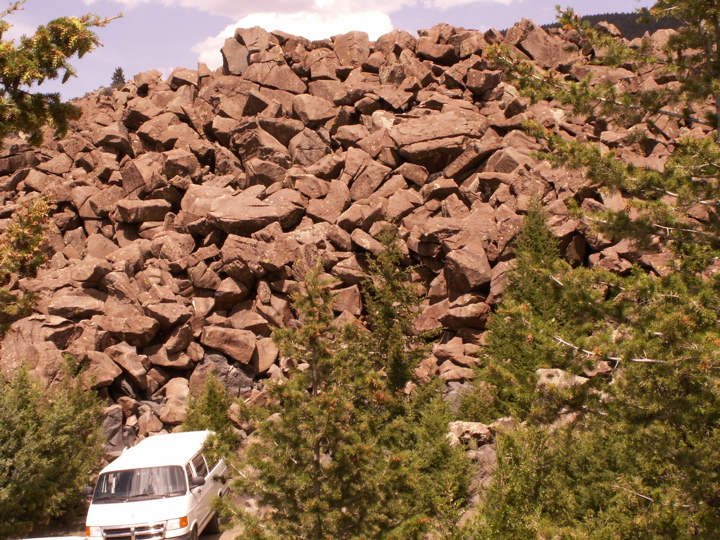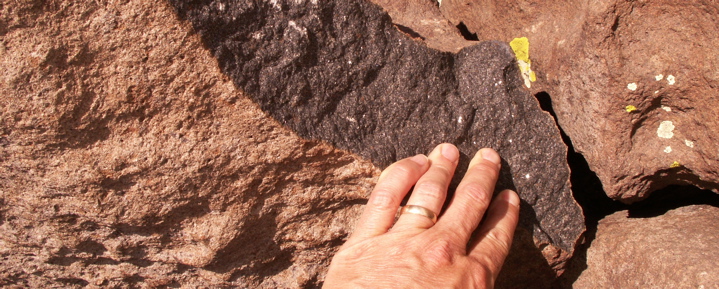|
Rock Music in the Boulder Batholith

"Ringing Rocks" (20 miles east of Butte, Montana: Map) is one of the most unusual rock formations in the country. A similar "ringing rock" formation exists in Pennsylvania. Folks from all over travel the three-mile gravel road north of I-90 just to pound on Montana's version of "Ringing Rocks" with hammers (Aerial Photo). To find out why, watch this 2-minute video. CLICK HERE. Be sure to have your computer's volume turned on as you watch.
Nobody knows for sure . . .
Exactly why the rocks ring like bells when struck with a hammer is a mystery. The rocks do contain a significant amount of iron, which might be part of the explanation. However, the high iron content doesn't explain two other strange qualities that the rocks possess . . . Not all of the rocks ring when struck, and they don't ring when they are removed from the site, suggesting that the ringing has something to do with the way the rocks lay against one another. Larger flat ones seem to produce an especially impressive sound when struck.
Compared to the neighbors . . .
The Ringing Rocks are very small part (160 acres) of a mountainous region called the Boulder Batholith, which encompasses a large portion of southwestern Montana. Batholiths originate when magma cools slowly beneath the surface to form granite. Then, if the land is uplifted, less durable rocks above the batholith tend to get eroded away, exposing the granite. Although it originated far beneath the surface, the Boulder Batholith now forms the mountains between Butte and Helena where travelers can see the light-colored granite exposed in outcroppings. Although the Ringing Rocks are part of the batholith, they differ from the rocks around them in two significant ways. For one, the Ringing Rocks are an iron-red color that contrasts with the light-gray granite that surrounds them. Another difference between the Ringing Rocks and their neighbors in the batholith is their shape. . . Granite in the batholith has weathered to form large boulders with rounded edges, whereas the Ringing Rocks are very angular with large flat surfaces. Click here to see a comparison.
Born of Fire . . .
One thing that the Ringing Rocks have in common with the surrounding granite is that they are both igneous rocks (formed as magma or lava cooled). When lava cools at the surface, the resulting igneous rock is classified as "volcanic" (aka extrusive). Basalt is the most common type of volcanic rock. If the rock formed as magma froze slowly beneath the surface, the rock is described as "plutonic" (aka intrusive). Granite is the most common type. Although the granite of the Boulder Batholith and the Ringing Rock formation are both plutonic in origin, the molten material that cooled to form the Ringing Rocks consisted of a much darker mix of minerals. As a result, the Ringing Rocks are a fairly unusual type of rock that geologists call gabbro.
Weathered, not deposited . . .
At first glance it looks like the Ringing Rocks were transported and deposited in a pile by some natural force. When rock materials are transported away from where they were formed, it is called "erosion". Although some of the rock material that made up the original mass of gabbro has been carried away (eroded), the Ringing Rocks sit in the place where they were formed. They were not transported from some place else and then deposited here. Instead the unusual shape and color of the Ringing Rocks can be attributed to "weathering". . . those processes that break down the rock. Apparently the gabbro developed quite a network of cracks (mechanical weathering), exposing surfaces for air and water to do their work (chemical weathering). Weathering shaped the solid mass of gabbro into large angular pieces shown in the photo above and erosion carried the weathered rock materials away. The iron-red surface color is a result of air and water reacting with iron to form a compound similar to rust. The broken Ringing Rock below shows how chemical weathering alters the appearance of the black gabbro.
To learn more about the Ringing Rocks of Montana, go to this Wikipedia page. Here is a geologic map of the Ringing Rocks. On the map the rocks are labelled "opm" (olivine pyroxene monzonite).
 No rocks were harmed in the making of this photo.
Confusing terminology . . .
Sometimes the way geologists use certain terms differs from the way those terms are used in the media, etc. Here are some examples related to the topics covered above.
erosion = weathering + erosion . . .
The common use of the word "erosion" is understood to include both weathering and erosion. To a geologist, "erosion" and "weathering" are two separate processes. Weathering is the breaking apart of rock, either into smaller pieces, or by dissolution (being dissolved). To a geologist, "erosion" is any process that transports rock material away. Running water transporting sand, silt, clay, dissolved minerals, etc. accounts for much of the erosion that happens in nature. When we say that a tombstone has been eroded (common use), what we are really saying is that it has experienced both weathering and erosion.
granite = rock . . .
No doubt you've heard of "granite" counter-tops. Not all granite counter-tops are really granite. The word "granite" as it is used in the marketing of counter-tops means any kind of rock. So "granite" counter-tops may be made of marble, gabbro, diorite, or other kinds of rock. To a geologist, "granite" is a specific type of course-grained, light-colored igneous rock.
granitic = plutonic or intrusive . . .
The word "granitic" is sometimes used to describe a rock that was formed as magma cooled slowly beneath the surface . . . as opposed to lava cooling more quickly above the surface. In this context, "granitic" has the same meaning as "plutonic" and "intrusive". Although there is a big difference between gabbro and granite, gabbro might be described as "granitic" because it was formed beneath the surface.
Terms: batholith, outcropping, plutonic
|



